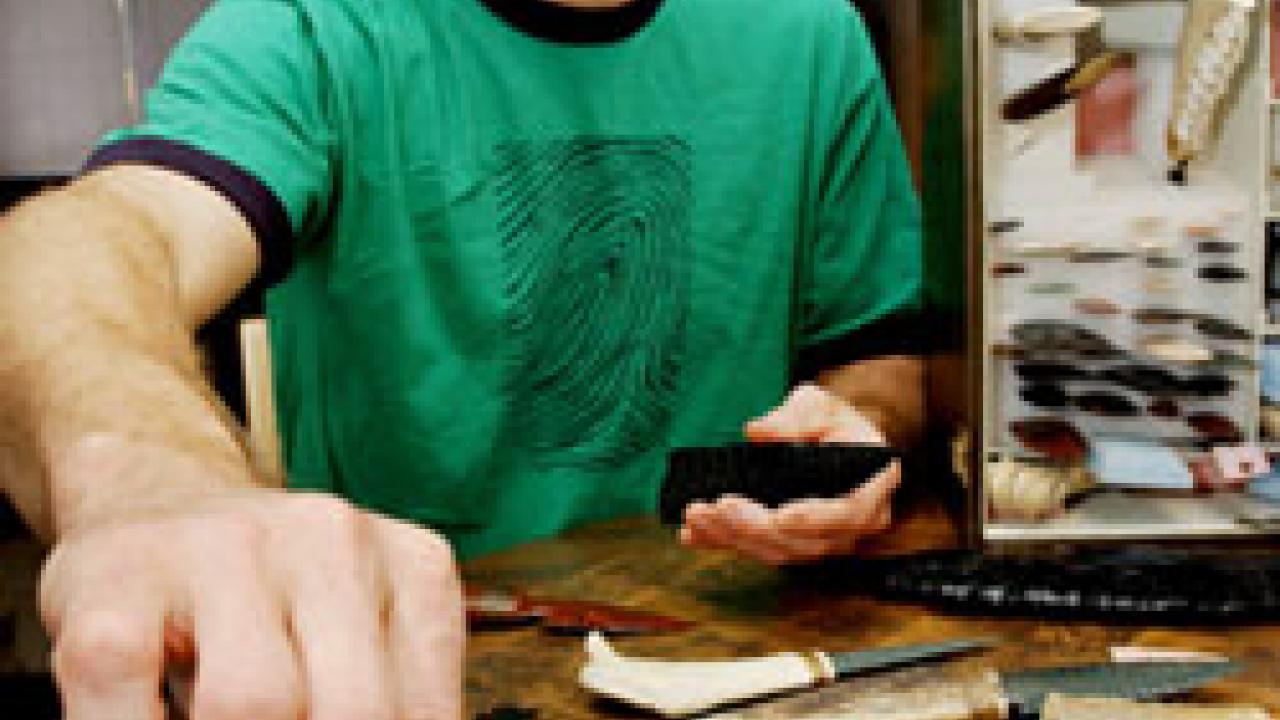Marc Salak is following his bliss -- and it's taken him to lost worlds.
From Aztec mines in Mexico to the mysterious Upper Amazon Basin and the wild jungles of New Guinea, Salak, a part-time instructor at the Craft Center, has traveled the world in search of antiquities. Who made them? How old are they? What's inside?
One does not put a label on Salak. He's part geologist and scientist, part archaeologist, part craftsman, part artist, and part cactus journalist (more about that later). What is certain is that this self-styled scholar is considered among the world's finest obsidian knappers.
Like Native Americans and other Stone Age peoples, Salak makes or "knaps" arrowheads, ceremonial objects and other prehistoric-style tools from obsidian, the hard volcanic glass often found by archaeologists in excavations. Filmmakers have sought him out as an expert.
"I try to imagine how people in the past survived without all the things we now have — cars, tools, sleeping bags," said Salak, who prefers a ruggedly simple life. No TV. No e-mail. No car loans or credit cards.
Salak's flint-shaping hands appear in "The Obsidian Trail," a documentary on ancient peoples of California that featured several UC Davis experts and appeared last year on KVIE and other public television stations.
It took Salak years to perfect the techniques for shaping or "knapping" the obsidian into useful objects. He started in 1988.
"Obsidian or flint will break the same in any direction," said Salak. "Obsidian is sharper than anything, extremely hard and you can create many useful shapes from it. That's why it was so highly valued by ancient peoples. It occurs in many places."
Salak, who holds a master's degree in geology from UC Davis, doesn't promote his craftsmaking -- but word-of-mouth about his work does the job. "I keep to myself," Salak said. A freedom-seeking approach allows him to explore a world seldom noticed by the rest of our supercharged society, he said.
Salak travels four or five months a year to places such as Africa, Peru, Ecuador, Bolivia, Mexico, New Guinea and the Malaysian Peninsula. One of his gigs involves working as a research assistant studying rivers in the Upper Amazon. He still finds time to get back to Da-vis, where he lives, to teach pottery, obsidian knapping and tie-dying at the Craft Center.
Salak is in the Guinness World Records for finding the world's tallest cactus. While trekking through the Sonoran Desert in Baja Mexico in 1995, Salak and a friend measured a cardon cactus (Pachycereus pringlei) that towers a mind-boggling 63 feet above the desert floor -- higher than most two- or three-story buildings.
"I visited it last winter and it may be even taller now," said Salak, who also writes occasionally for the Cactus and Succulent Journal. "It doesn't pay anything," he notes about the journal. His sister, Kira, writes for National Geographic.
One spies a pillow in Salak's living room -- no ordinary one, but one with hideous jaws poking out. One of Salak's creations, it involved inserting triggerfish snouts into a leather pillow. Just don't sit on it, he said.
Salak has a booth at the Whole Earth Festival to showcase some of his heavy metal work. As a welder, he makes lamps, candlesticks and sculpture from transmission and engine parts such as gears, springs, shafts and bearings. An example of "high post-industrialism," he said.
Then, every June and July, Salak returns to his native roots in Chicago to sell tie-dye clothing at festivals. It gives him a chance to also see family, he said.
Why did you choose your field?
I've always collected rocks and fossils as a kid. I grew up in a suburb of Chicago, so I never found arrowheads around there. It's therapeutic to make arrowheads. I don't try to hunt with these arrowheads, but they sort of represent a gateway into the past. In graduate school I studied the Cambrian Period of about 543 to 490 million years ago -- during the "Cambrian Explosion" animals suddenly developed skeletons and life poured forth.
What do you like most about your career?
I have the time to travel because I have no regular full-time job. I could be working for Exxon like a lot of the people I went to school with.
And the least?
Paying for airfares. I'm just back from New Guinea and it cost $2,000 roundtrip. I was exploring ancient obsidian mines there and teaching some of the villagers how to knap.
Any close calls on your trips abroad?
In December 2002, we drove into Zimbabwe while the whole country was basically collapsing. It was hard crossing the border. The military was extorting people. We made it out after paying a lot of money and fees, and along the way were chased by thugs.
Otherwise, I've never gotten too sick, though many of my fellow travelers have suffered some horrible diseases. We do all sorts of activities, from long hikes to scuba diving and mountain climbing.
Read any good books lately?
One of my favorites is Thomas Pynchon's Gravity's Rainbow. My scientific training helps me to appreciate this book, which includes a blizzard of references to science, history, power, human nature and the lowest of jokes. I can relate to the way he portrays humanity.
What's something surprising about you?
My girlfriend is a corporate attorney from Los Angeles. We've been dating almost two years. Most of my friends are anarchists from back east, so they would find this surprising.
What are some of your most treasured possessions?
My truck. I don't want it to break down. I usually drive to Mexico. It's an '88 Toyota.
Do you have a guilty pleasure?
Durian, a fruit found on the Malaysian peninsula. Durian smells so bad that hotels in that part of the world do not allow it on their premises. But I love it. •
